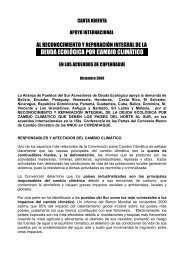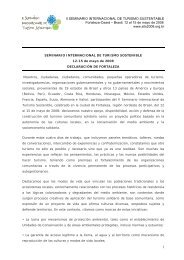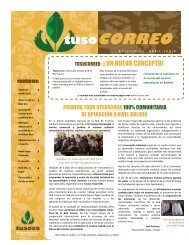Beyond Greening - Tourism Watch
Beyond Greening - Tourism Watch
Beyond Greening - Tourism Watch
Create successful ePaper yourself
Turn your PDF publications into a flip-book with our unique Google optimized e-Paper software.
<strong>Beyond</strong> <strong>Greening</strong>: Reflections on <strong>Tourism</strong> in the Rio-Process | PositioningpaperTimber Forest Products – NTFP, timber, entry fees, etc.) go into a common pool wherein allnon-plan income of the state is parked, from where allocations for different expenses aremade. There is no way to ensure that the incomes from tourism are ploughed back to theForest Department for regeneration work. Therefore, the only directly traceable benefit issalaries people receive when they are employed at tourism sites. This creates a rupture in theidea that ecotourism can be used as an income generation method for forest conservation.Madhya Pradesh is the only state where each national park has created a fund into whichmoney collected through gate receipts feeds.It has been found that almost 70 percent of income from wildlife tourism is from the feescollected at the entry gate, which means the larger the number of tourists, the greater theearnings of the Forest Department. This is in complete opposition to the concept ofecotourism. Additionally, the large sunk cost of tourism infrastructure developed at the sitesbecomes redundant since many tourists prefer day visits to overnight stays(Swaminathan/Purushothaman, 2000).One of the aspirations for ecotourism isconservation education of the tourists.However, not much has been done byway of actualising this potential. A part ofthe conservation education is to alsorecognise the role that local communitieshave historically played in theconservation of the country’s naturalresources and the continued struggle todo this in the light of a fast developingnation. This will instil respect for localcommunities in the tourists and willchange the perspective with which they are viewed. The change in the mind set of touriststowards local communities would also positively influence their behaviour vis-à-vis localcommunities, which today is oppressive, patronising and condescending.The mainstream notion of conservation overlooks and does not acknowledge the role that isplayed by adivasis and other forest dwelling communities in conserving the forests as well asthe diversity. Forms of conservation are also very often indigenous in nature and are tied withthe religious and spiritual beliefs of communities. Some of the conservation practices that havebeen recorded are the existence of sacred groves, "navai", a harvest festival in Western MadhyaPradesh, during which the "gayana" is performed. The "gayana" chronicles the evolution ofhumankind. It is an oral tradition teaching the future generation their past and possiblyindicating their future by describing the symbiotic relationship that exists between man andnature and the importance of this relationship for sustenance. This instils in the youngergenerations a respect for nature while also teaching them about their rights to the forest 22Ecotourism, Employment and LivelihoodsThe forests, in the form of protected areas, national parks and wildlife sanctuaries, are themain tourism product in ecotourism. The creation of these areas has caused land alienationand displacement in large numbers. This change in land use pattern and land dispossession,lack of access to forest resources has led to social injustices like loss of dignity and livelihoods22See “In the Belly of the River: Tribal Conflicts over Development in the Narmada Valley (Studies in Social Ecology and EnvironmentalHistory) by Amita Baviskar, Oxford University Press, 200529












